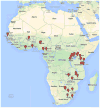An Insight Into Cervical Cancer Screening and Treatment Capacity in Sub Saharan Africa
- PMID: 26579842
- PMCID: PMC4691409
- DOI: 10.1097/LGT.0000000000000165
An Insight Into Cervical Cancer Screening and Treatment Capacity in Sub Saharan Africa
Abstract
Objective: Approximately 85% of cervical cancer cases and deaths occur in resource-constrained countries where best practices for prevention, particularly for women with HIV infection, still need to be developed. The aim of this study was to assess cervical cancer prevention capacity in select HIV clinics located in resource-constrained countries.
Materials and methods: A cross-sectional survey of sub-Saharan African sites of 4 National Institutes of Health-funded HIV/AIDS networks was conducted. Sites were surveyed on the availability of cervical cancer screening and treatment among women with HIV infection and without HIV infection. Descriptive statistics and χ or Fisher exact test were used as appropriate.
Results: Fifty-one (65%) of 78 sites responded. Access to cervical cancer screening was reported by 49 sites (96%). Of these sites, 39 (80%) performed screening on-site. Central African sites were less likely to have screening on-site (p = .02) versus other areas. Visual inspection with acetic acid and Pap testing were the most commonly available on-site screening methods at 31 (79%) and 26 (67%) sites, respectively. High-risk HPV testing was available at 29% of sites with visual inspection with acetic acid and 50% of sites with Pap testing. Cryotherapy and radical hysterectomy were the most commonly available on-site treatment methods for premalignant and malignant lesions at 29 (74%) and 18 (46%) sites, respectively.
Conclusions: Despite limited resources, most sites surveyed had the capacity to perform cervical cancer screening and treatment. The existing infrastructure of HIV clinical and research sites may provide the ideal framework for scale-up of cervical cancer prevention in resource-constrained countries with a high burden of cervical dysplasia.
Conflict of interest statement
Conflict of Interest: none
References
-
- Ferlay J, Soeriomataram I, Ervik M, Forman D, Bray F. Cancer IAfRo, editor. Estimated Cancer Incidence, Mortality, and Prevalence Worldwide in 2012. Lyon, France: 2012.
-
- World Health Organization. Comprehensive cervical cancer prevention and control: a healthier future for girls and women. Switzerland: 2013.
-
- Jemal A, Bray F, Forman D, O’Brien M, Ferlay J, Center M, Parkin DM. Cancer burden in Africa and opportunities for prevention. Cancer. 2012;118(18):4372–4384. - PubMed
-
- National Cancer Institute; Health NIo, editor. Cervical Cancer. 2014.
-
- Firnhaber C, Zungu K, Levin S, Michelow P, Montaner LJ, McPhail P, Williamson AL, Allan BR, Van der Horst C, Rinas A, et al. Diverse and high prevalence of human papillomavirus associated with a significant high rate of cervical dysplasia in human immunodeficiency virus-infected women in Johannesburg, South Africa. Acta cytologica. 2009;53(1):10–17. - PMC - PubMed
Publication types
MeSH terms
Grants and funding
- UM1 AI069472/AI/NIAID NIH HHS/United States
- P30AI42853/AI/NIAID NIH HHS/United States
- P30 AI094189/AI/NIAID NIH HHS/United States
- P30AI094189/AI/NIAID NIH HHS/United States
- U10AI069472/AI/NIAID NIH HHS/United States
- P30 AI051519/AI/NIAID NIH HHS/United States
- P30AI060354/AI/NIAID NIH HHS/United States
- 5P30AI051519/AI/NIAID NIH HHS/United States
- UM1 A1068636/PHS HHS/United States
- U01AI069911/AI/NIAID NIH HHS/United States
- 5P30AI050410/AI/NIAID NIH HHS/United States
- 5P30AI027757/AI/NIAID NIH HHS/United States
- U01 AI069911/AI/NIAID NIH HHS/United States
- UL1 TR001073/TR/NCATS NIH HHS/United States
- U01AI069919/AI/NIAID NIH HHS/United States
- P30 AI027763/AI/NIAID NIH HHS/United States
- U01 AI069919/AI/NIAID NIH HHS/United States
- P30 AI027757/AI/NIAID NIH HHS/United States
- P30 AI042853/AI/NIAID NIH HHS/United States
- 5P30AI036219/AI/NIAID NIH HHS/United States
- 5P30AI027763/AI/NIAID NIH HHS/United States
- P30 AI060354/AI/NIAID NIH HHS/United States
- P30 AI036219/AI/NIAID NIH HHS/United States
- U01 AI069472/AI/NIAID NIH HHS/United States
- P30 AI050410/AI/NIAID NIH HHS/United States
LinkOut - more resources
Full Text Sources
Other Literature Sources
Medical
Research Materials


